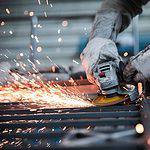Today we will discuss about difference between up millingand down milling. The milling is a machining process in which, a rotary cutter iused to remove the material from work piece in the direction perpendicular t the axis of rotation. The milling process is done by the machine, which hold bot the tool and work piece in jig and fixture, known as milling machine. There are two ways to cut the material from the work piece through milling machine. First one is named as conventional milling or Up milling and the other one known as climb milling or down milling. The main and basic difference between up milling and down milling is the direction of rotation of cutter to the feed.
The milling operation is used to facing of those work piece, which are not symmetrical from its axis. It is also used to cut pockets, drill, slot and shape the work piece according to the requirement.
In down milling, the cutter rotates clockwise while cutting the work piece from left to right. In this milling operation, the tool spins with the direction of feed. The cutting chips are carried downward by the tool.
Difference between Up milling and Down milling:
Up Milling | Down Milling | |
1. | In up milling the cutter rotates against direction of feed. | In Down milling, the cutter rotates with direction of feed. |
2. | It is also known as conventional milling. | It is also known as climb milling. |
3. | In this, chip width size is zero at initial cut and increase with feed. It is maximum at the end of feed. | In this cutting process, chip size is maximum at start of cut and decrease with the feed. It is zero at the end of feed. |
4. | In this process, heat is diffuse to the work piece which causes the change in metal properties. | In down milling most of heat diffuse to the chip does not change the work piece properties. |
5. | In up milling, tool wear is more because the tool runs against the feed. | In this, tool wear is less compare to the up milling, due to the cutter rotate with the feed. |
6. | Tool life is low. | Tool life is high. |
7. | The cutting chips are carried upward by the tool so known as up milling. | The chips are carried downward by the tool so known as down milling. |
8. | The cutting chips fall down in front of the cutting tool which again cut the chips cause less surface finish. | The cutting chips fall down behind the tool. This gives better surface finish. |
9. | Due to upward force by tool, high strength zig and fixture required to hold the work piece. | In down milling, downward force act on work piece normal zig and fixture required. |
10. | It is the traditional way of cutting the work piece. | It is non-traditional way, but now days, down milling used more than up milling. |
11. | High quality cutting fluid is required because heat diffuse in the work piece. | In this process heat does not diffuse in the work piece, so simple cutting fluid is required. |
12. | It required high cutting force compare to down milling. | It required low cutting force. |








What about the surface finish
Nice explanation. Thank you.
Very easy and helpful explanation.
Thank you
Thank you…
What is advantage of up milling
Suited to machine thin & hard
hold points.
Constitent parallel size may be mountained partially on that parts.
It requires upto 20% less power to cut by up milling method or process.
Nice
Good explanation
Thank you for good explanation…
Please explain all different types of milling process
( ie end, surface )
Thanks for excellent explain with such an ease
In which case do we use up milling and in which case down milling?
Thanks…
Easy to understand
Awsum fiArticle
WhatAbout specific power consumption?
what about the backlash?
well explained thank you
Which is the high friction in up milling or down milling?
Very good explanation. Thanks
Good
simple to understand